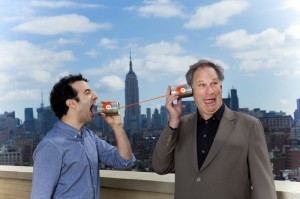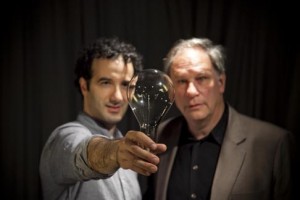On Radio: Radiolab and the Art of the Modern Radio Feature

On Radio is a new Antenna column dedicated to contemporary radio programming and other issues surrounding the medium in all its forms.
Hands down, Radiolab is the most interesting American radio program of the past decade. Although, that’s not a particularly bold claim, really, as there are plenty of people out there who have heaped similar praise upon the series, not least of all Ira Glass and the MacArthur genius grant folks. Produced by the New York City public radio station WNYC and distributed nationally through National Public Radio (NPR), Radiolab is a math, science, and philosophy show hosted by Jad Abumrad and Robert Krulwich. The program deals with “big questions,” as their website puts it – things like life, death, knowledge, the universe – typically through broadly themed episodes on topics such as laughter, the human brain, race, time, deception, and randomness. Radiolab is a radio feature in that it is a (mostly) non-fiction program that mixes fairly traditional elements of journalism and news reporting with more artistic and dramatic elements. If non-music radio programming can be placed on a continuum with straight news talk placed at one extreme and the fictionalized radio drama at the other, then the radio feature (or “radio documentary,” as John Biewen and other radio producers refer to it) is situated somewhere in the middle, a mix of words, sounds, and music that merges the informational content of journalism with the form and emotion of art.
Just as standard NPR news programs like All Things Considered are often called “news magazines,” in that they consist of numerous stories reported more in-depth than standard “headline news” style broadcasts, the term “radio feature” insinuates an even more extended, highly focused examination of a story or topic, similar to a thoroughly researched and contextualized cover story in a print magazine. Often, as is the case with Radiolab and also This American Life, multiple stories may be covered within an hour-long episode, but they nevertheless all tie into an overarching theme or narrative. This is not breaking news, even though it is journalistic in the sense that it is informative, educational, and frequently timely and topical.
Emphasis is placed on characters – people – who the audience is invited to identify with through fleshed out, exceptionally visualized scenes. This is where the artistic and dramatic elements come in: the focus of a radio feature like Radiolab is on storytelling rather than mere reporting of events and facts, and this is often achieved through vertically structured and intimate, slice-of-life narratives. NPR’s news magazines regularly attempt to craft similar segments, but what really sets a radio feature apart is its meticulous attention to form – Biewen, in the introduction to his edited volume Reality Radio (University of North Carolina Press, 2010), calls radio documentarians “journalists/artists” who “use sound to tell true stories artfully.” This emphasis on form can range from simply playing with voice and basic narrative structure to experimenting wildly with actuality sound and music in a way that verges on sound art – it does not always need to be “complex” or affectedly avant-garde. Still, radio features are able to sidestep conventions and engage in a level of experimentation that standard radio news programming rarely, if ever, does.
 Radiolab tends more toward the “wild experimentation” end of that spectrum, even though the core of its aesthetic is what host Jad Abumrad, in an essay he penned in Reality Radio, describes as “the pleasant illusion of ‘two guys chatting’.” He’s referring here to the back-and-forth dialogue that occurs between co-hosts Abumrad (pictured left) and Robert Krulwich (pictured right) – a loose, conversational style that is also extended to the discussions between the hosts and their interviewees. And indeed, there is an emphasis placed on voice and narration – the voices of the hosts and interviewees stitched together to recount experience. Still, the show is, at its most basic, “about curiosity and discovery,” to quote Abumrad again, and this inquisitive, innovative spirit is extended from the show’s focus on “big ideas” to the way it explores, through sound, those ideas.
Radiolab tends more toward the “wild experimentation” end of that spectrum, even though the core of its aesthetic is what host Jad Abumrad, in an essay he penned in Reality Radio, describes as “the pleasant illusion of ‘two guys chatting’.” He’s referring here to the back-and-forth dialogue that occurs between co-hosts Abumrad (pictured left) and Robert Krulwich (pictured right) – a loose, conversational style that is also extended to the discussions between the hosts and their interviewees. And indeed, there is an emphasis placed on voice and narration – the voices of the hosts and interviewees stitched together to recount experience. Still, the show is, at its most basic, “about curiosity and discovery,” to quote Abumrad again, and this inquisitive, innovative spirit is extended from the show’s focus on “big ideas” to the way it explores, through sound, those ideas.
Most notably, the producers quickly and often abruptly butt voices up against one another, as well as layer voices on top of each other and then layer atmospheric sound, sound effects, and music on top of (or underneath) it all. For instance, in the recent Radiolab episode “Patient Zero,” the hosts examine the concept of “patient zero,” meaning the case that can be identified as the starting point of an outbreak. They begin with the story of Typhoid Mary, the woman who has been commonly understood as the source of the first typhoid fever outbreak in the United States, in the early 1900s in the New York City area. But in fact, they begin the episode somewhat confusingly with a pair of producers randomly speaking to one another (“So have I said where we are? Am I on tape yet?”) in what is clearly an outdoor environment, a brisk wind creating loud distortion in the microphone. Abumrad quickly identifies the producers but does not otherwise introduce the story or the episode. Returning to the actuality sound, one of the producers explains from the field that they are on an abandoned island where a woman with an infectious disease was at one time quarantined, but the exact location and identity of the woman are still unnamed. Then, Abumrad and Krulwich begin their host narration, which takes the form of a conversational, improvisational-sounding dialogue. Krulwich asks, “This is a story that begins when?” to which Abumrad responds, “Well, actually, it starts in 1906….” The narration continues in this conversational back-and-forth mode for awhile, Krulwich playing the inquisitor to Abumrad’s more authoritative storyteller, though quickly a third voice joins the conversation, that of UW-Madison medical historian Judith Leavitt. This is clearly a storytelling style compared to news radio’s standard narrative flow of a host intro and hook followed by a reporter opening. Information is revealed quickly and yet incrementally, and much attention is paid to context and creating a visual image for the audience to imagine. Rather than the thesis, characters, and scene all being set immediately, it is two minutes into the episode before it is clearly established that they are talking about a typhoid outbreak, it is more than three-and-a-half minutes before it is announced that this is the story of Typhoid Mary, and it is not until after the four-minute mark that Abumrad and Krulwich announce the theme of the episode.
Radiolab is about exploring ideas – big, difficult, abstract ideas – and more than anything it achieves that through experience. Here, experience is meant in a double-sense: creating a fun, adventurous listening experience for the listener, as well as connecting, through intimacy and description, to universal thoughts and feelings that the audience will be acquainted with personally. For instance, the tone is loose, accessible, even fun, with digressions and moments of humor interjected. The dual narrator device functions to bring the audience into the story, Abumrad and Krulwich expressing amazement and asking each other questions in a way that often reflects what the listening audience is likely to be thinking. The banter also underlines the sense of discovery. For instance, when a startling point is revealed, the narrator’s stop and spontaneously declare, “Really?!” Moreover, the back-and-forth dialogue also functions as a kind of theater, more akin to a radio play than a news story. This intimate, first-person narration builds tension and draws the listener in, like a group of friends telling an amazing story at a bar.
 Music is particularly integral to Radiolab’s aesthetic. Referring again to the “Patient Zero” episode, almost as soon as Abumrad and Krulwich’s introduction starts, musical stings begin to creep into the piece. At first, these are curious sounding, modern classical style piano and string arrangements that quietly stay beneath the voices, mostly solitary notes that sound as though they are searching for something. However, as the Typhoid Mary story begins to build with Abumrad, Krulwich, and Leavitt describing the typhoid outbreak of 1906, the music perks up, horn bursts and tense strings serving to underline the impending danger. The voices and music continue this way, emphasizing and building upon one another in a montage fashion. Pauses and silences are interspersed to highlight moments of confusion or revelation.
Music is particularly integral to Radiolab’s aesthetic. Referring again to the “Patient Zero” episode, almost as soon as Abumrad and Krulwich’s introduction starts, musical stings begin to creep into the piece. At first, these are curious sounding, modern classical style piano and string arrangements that quietly stay beneath the voices, mostly solitary notes that sound as though they are searching for something. However, as the Typhoid Mary story begins to build with Abumrad, Krulwich, and Leavitt describing the typhoid outbreak of 1906, the music perks up, horn bursts and tense strings serving to underline the impending danger. The voices and music continue this way, emphasizing and building upon one another in a montage fashion. Pauses and silences are interspersed to highlight moments of confusion or revelation.
Indeed, these elements all work together to make Radiolab sound like the process of intellectual discovery – it is the research and problem-solving process manifested audibly.


